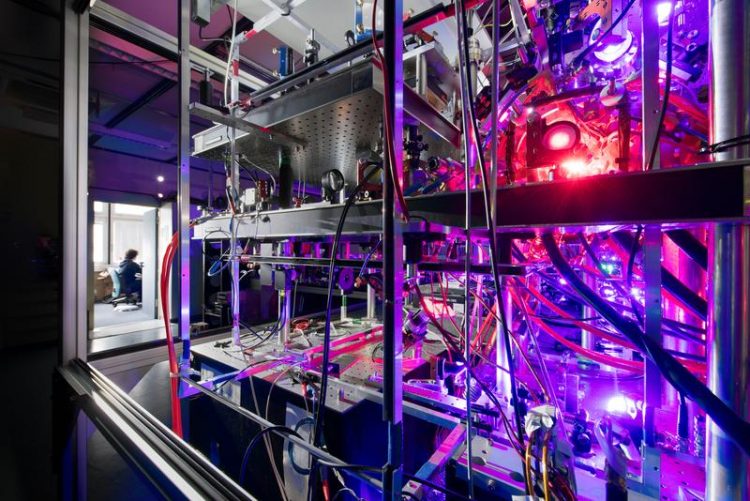Physicists from Stuttgart prove the existence of a supersolid state of matte

This image shows parts of the experimental laser setup used by the researchers in Stuttgart to create a supersolid from ultracold dysprosium atoms. ble University of Stuttgart / Wolfram Scheible
In our everyday lives, we are familiar with matter existing in three different states: solid, liquid, or gas. However, if matter is cooled down to extremely low temperatures, quantum effects can also enable other states of matter. This includes superfluids, which are characterized by a frictionless flow of atoms.
Moreover, in the quantum world, particles can exist in superpositions of being unpredictably and randomly in two different locations.
It had long been conjectured that even superpositions of states of matter are possible. According to these ideas, known states of matter, such as solid or fluid, can thus be superimposed to form new states of matter with new properties.
A supersolid is exactly such a superposition state, and features both the crystalline structure of a solid and the frictionless flow of a superfluid. In such a state every atom is unpredictably and randomly either part of the solid or of the superfluid.
In the experiments in Stuttgart, the supersolid is generated from dysprosium atoms that behave like tiny magnets. These atoms are cooled down to near absolute zero (-273° Celsius). At this point, two types of interaction between atoms become important: if two atoms come very close together, they collide like billiard balls.
At the same time, they can attract or repel each other over larger distances due to the magnetic interaction. To generate a supersolid, the researchers adjusted the relationship between these two forces such that a crystalline lattice structure and superfluidity are created simultaneously.
“We were able to observe the periodicity of the crystal directly with a microscope, and tested the quantum mechanical superposition through interference experiments” explain Mingyang Guo and Fabian Böttcher, postdoc and doctoral student at the experiment.
Detection by means of sound waves
The definitive proof that the matter created in the experiment is indeed a supersolid is based on the observation of two kinds of sound waves that travel through the supersolid at different speeds. Such sound waves propagate differently in different materials – in air, for example, sound waves travel much slower than in water.
This “normal” sound wave is also present in the supersolid. However, because the supersolid is at the same time solid and fluid, a characteristic second form of sound wave can be observed, in which the crystal and the superfluid move against each other. This results in sound waves that travel at very low speeds, which the researchers in Stuttgart were able to observe for the first time in their experiment.
In recent years, several observations of a supersolid have been reported, but it later turned out that only one form of sound wave was present. “Using our experiment with ultracold dysprosium atoms, we have now succeeded for the first time in observing simultaneously all defining properties of a supersolid state” Tilman Pfau summarizes. The experiments in Stuttgart now open up the possibility to study the exotic properties of this new state of matter in unprecedented detail.
Prof. Tilman Pfau, University of Stuttgart, 5th Institute of Physics,
Tel. +49 711 685-68025, E-Mail: t.pfau (at) physik.uni-stuttgart.de
“The low-energy Goldstone mode in a trapped dipolar supersolid”
Mingyang Guo, Fabian Böttcher, Jens Hertkorn, Jan-Niklas Schmidt, Matthias Wenzel, Hans Peter Büchler, Tim Langen, Tilman Pfau
Nature, (2019)
https://www.nature.com/articles/s41586-019-1569-5 Original Publication
https://youtu.be/7cMuC0d0VYA Video
Media Contact
More Information:
http://www.uni-stuttgart.de/All latest news from the category: Physics and Astronomy
This area deals with the fundamental laws and building blocks of nature and how they interact, the properties and the behavior of matter, and research into space and time and their structures.
innovations-report provides in-depth reports and articles on subjects such as astrophysics, laser technologies, nuclear, quantum, particle and solid-state physics, nanotechnologies, planetary research and findings (Mars, Venus) and developments related to the Hubble Telescope.
Newest articles

Bringing bio-inspired robots to life
Nebraska researcher Eric Markvicka gets NSF CAREER Award to pursue manufacture of novel materials for soft robotics and stretchable electronics. Engineers are increasingly eager to develop robots that mimic the…

Bella moths use poison to attract mates
Scientists are closer to finding out how. Pyrrolizidine alkaloids are as bitter and toxic as they are hard to pronounce. They’re produced by several different types of plants and are…

AI tool creates ‘synthetic’ images of cells
…for enhanced microscopy analysis. Observing individual cells through microscopes can reveal a range of important cell biological phenomena that frequently play a role in human diseases, but the process of…





















